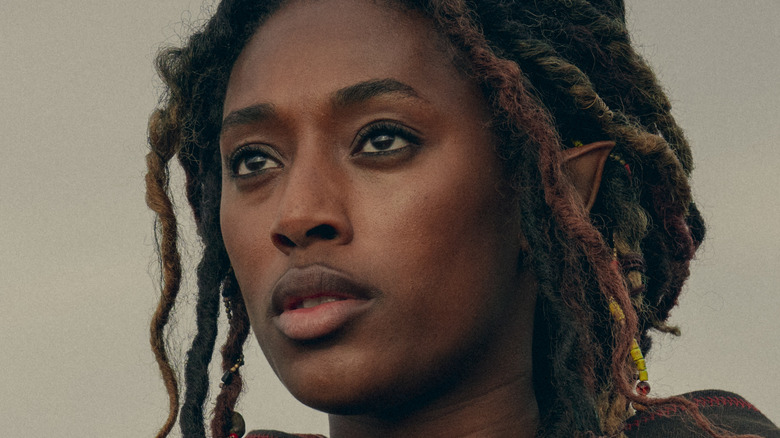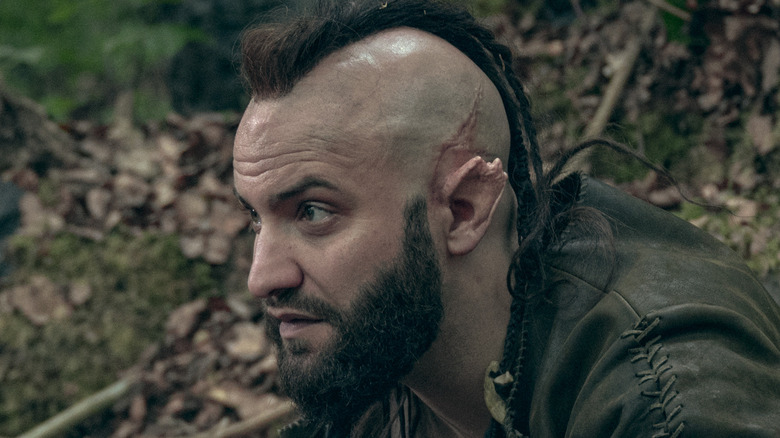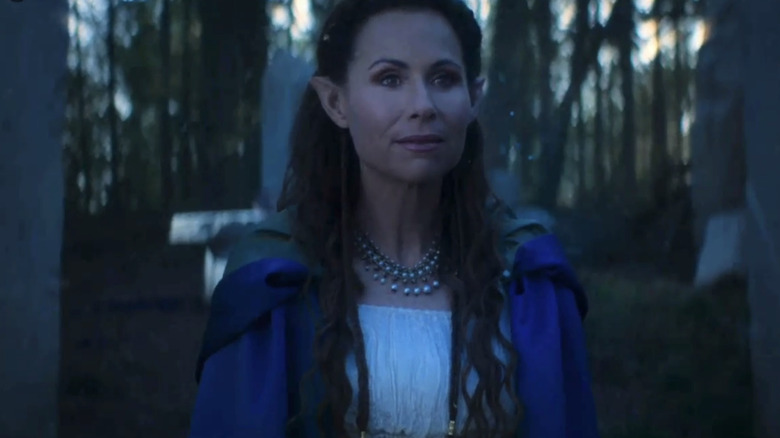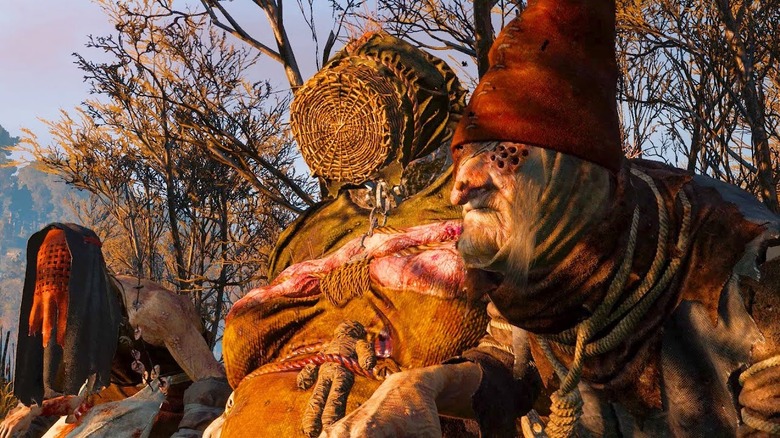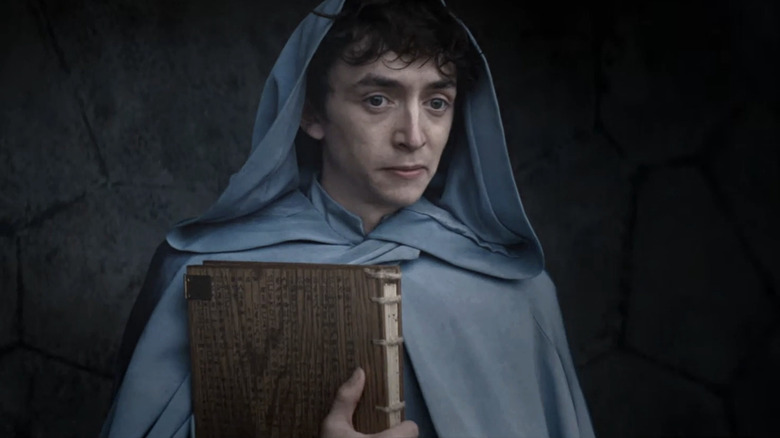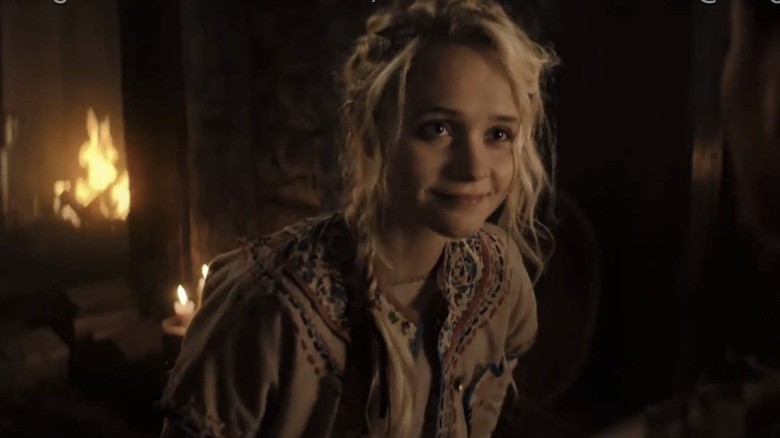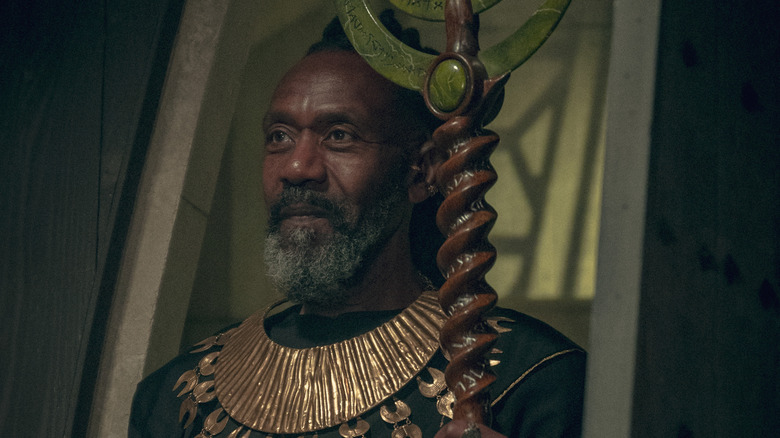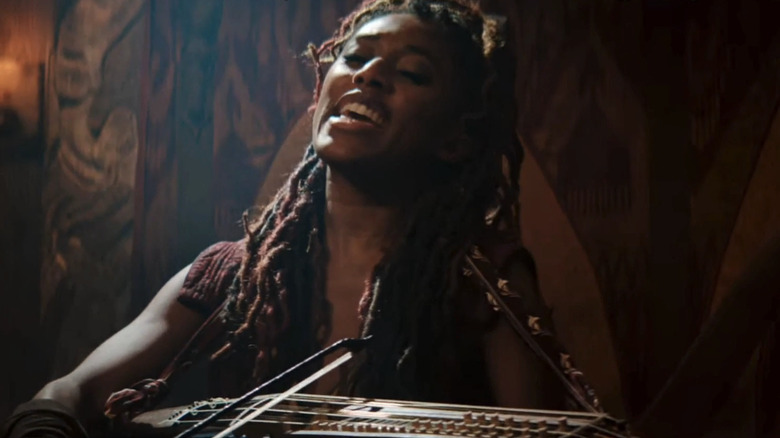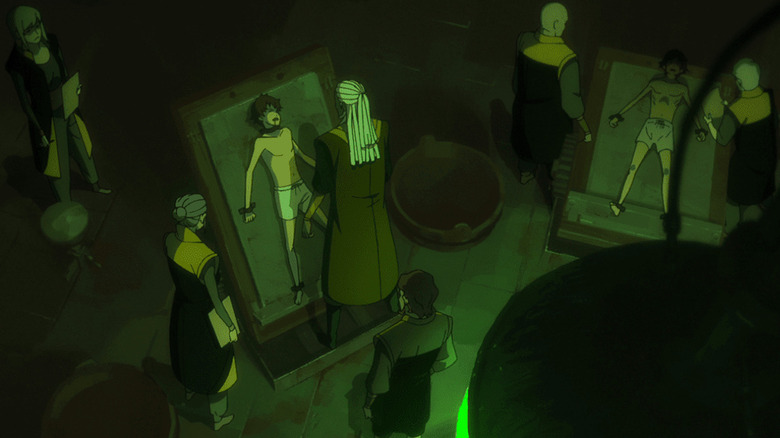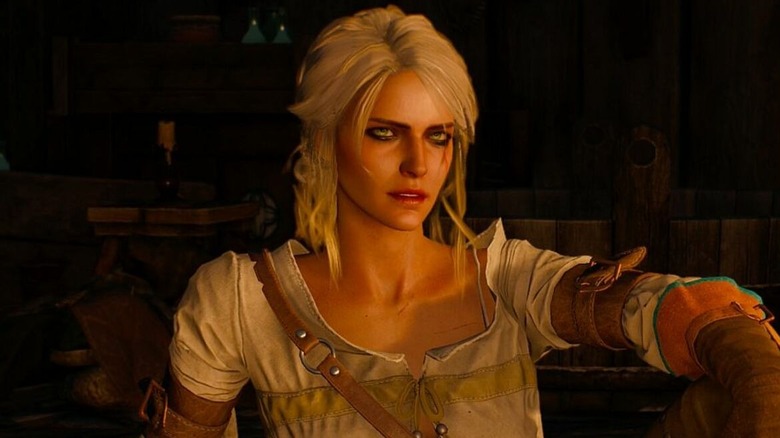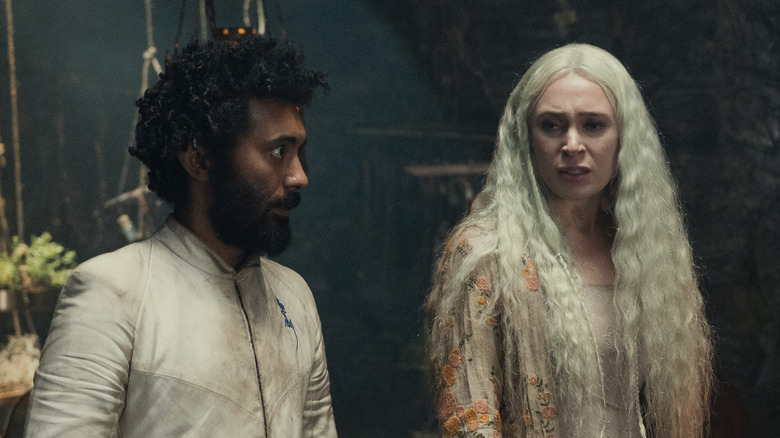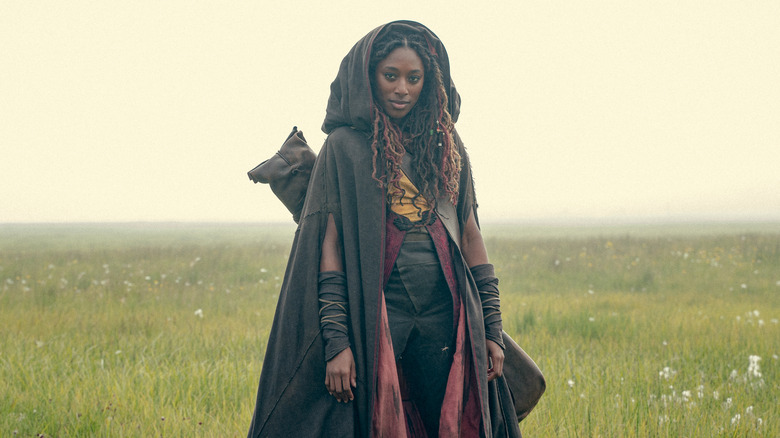Small Details You Missed In The Witcher: Blood Origin
The World of the Witcher continues to expand on Netflix with the arrival of "The Witcher: Blood Origin," an original miniseries set 1,200 years before the events of "The Witcher." True to its name, it establishes an origin for a number of important concepts and phenomena in the franchise's canon, like the Conjunction of the Spheres, the Wild Hunt, and of course, the first Witcher. With such a massive amount of lore to explain and story to tell, you might be surprised to hear that "The Witcher: Blood Origin" is jam-packed with Easter eggs and sly references, as well. Like its band of traveling protagonists, the series covers a lot of ground within the World of the Witcher.
Over the course of its four-episode season, "The Witcher: Blood Origin" manages nods to other Netflix series, the source novels by Andrzej Sapkowski, and even the popular video game series. A few come in the form of joking, meta-referential dialogue, some as aesthetic and thematic homages, and some even as bonus origin stories you might not even notice, but all of them serve to connect the franchise and its characters more tightly than ever. As a sample of that new connection, here are some of the best small details you missed in "The Witcher: Blood Origin."
Poisoned sheep
A particularly joyous Easter egg comes in the third episode of "The Witcher: Blood Origin," when the show's hodgepodge team of unlikely misfits strategize over how to defeat an interdimensional monster. With the group all but accepting their powerlessness, Brother Death (Huw Novelli) offers, "Why don't we poison a sheep and feed it to it?" As befitting such an absurd idea, the only response from the group comes from Fjall (Laurence O'Fuarain), who curses under his breath. The moment is a funny one on its own, but it becomes even funnier when you realize that the idea is a direct reference to both the "Witcher" books and the main Netflix series, which feature the very same sheep-based strategy.
In "The Bounds of Reason," a short story in the book "Sword of Destiny," Geralt and a large band of adventurers hunt for an alleged golden dragon that has been terrorizing a small village. Before Geralt's arrival, a local named Sheepbagger had filled a dead sheep with a number of poisons, which apparently worked and killed the dragon. Geralt arrives as another dragon begins attacking anew, and once again, Sheepbagger offers a poisoned sheep as a plan. The story is adapted for the sixth episode of Season 1 of "The Witcher," this time without Sheepbagger and his ovine offense.
Seanchai or Gaunter?
As "The Witcher: Blood Origin" begins, we're treated to a surprise scene starring everyone's favorite lecherous bard, Jaskier (Joey Batey), in the modern era (relative to "The Witcher" series). Though he's saved from a chaotic scene of blood and death, it's obvious that he isn't out of the woods when his rescuer is revealed: the mysterious, inhuman, inexplicable figure known as Seanchai (Minnie Driver). Seanchai's rescue is as horrifying as the battle before it, as is her inestimable amount of magic power, much of which she shares with another mysterious figure from the Witcher lore: Gaunter O'Dimm from the video game "The Witcher III."
In the game, O'Dimm takes a special interest in Geralt, which he never quite explains and results in the figure helping and harming the Witcher's quest according to his whim. Likewise, Seanchai takes a special interest in Jaskier, which she also never explains, aside from calling herself a fellow storyteller. As both O'Dimm and Seanchai upend Geralt and Jaskier's lives, respectively, they display a striking amount of similarities in their godlike powers and dubious morality. Both display the ability to freeze time completely, and both wander freely among the frozen populace, aiding or killing them at will. In "The Witcher III," for example, O'Dimm kills a random time-frozen human by pushing a spoon through his eye, while in "The Witcher: Blood Origin," Seanchai kills a random time-frozen human by causing flowers to grow from his throat.
The Ladies of the Wood
Within moments of meeting him/her/them/it, it is painfully obvious that there is more to Seanchai than meets the eye — especially to the soldier whose insides she turns into flowers. Yet pinpointing exactly what she is becomes impossible for Jaskier, and for fans. There is one moment, however, in which she may reveal her true form, and whether it's real or not, it is almost certainly a reference to some of the franchise's most notorious villains.
After first appearing to Jaskier in his own form, prompting a number of questions for the bard, Seanchai tells him, "I have other faces ... if you prefer." During that pause in her answer, she changes shape from a Jaskier clone to some unknown, hideous monstrosity. It is a tall, thick humanoid, and its head is covered in a bulky, webbed mask. The combination of that shape and that mask strongly resembles the Crones, or Ladies of the Wood, from "The Witcher III," specifically the hulking Brewess.
Brewess and her two sisters may have been referenced on Netflix before, in the form of the Cabin Witch from Season 2 of "The Witcher." The Cabin Witch, Seanchai, and the Crones all share a number of traits, many of which can be traced back to the Slavic folklore figure Baba Yaga. Whether or not Seanchai is revealed to be one of the Crones or not, she is certainly a part of the Netflix series' habit of hinting at their existence.
Avallac'h
There are a few characters in "The Witcher: Blood Origin" whose importance to the series is obvious to even the most casual of fans, like Fjall, the first to undergo the Trial of the Grasses and become a monster-slaying Witcher. Then there are those characters whose importance goes unexplained by the series's end, leaving them as tantalizing leads for only deep fans to detect. In "The Witcher: Blood Origin," there is no character whose importance to the story is more significant than it seems than Avallac'h, the young Elvish apprentice.
As of this writing, the role of Avallac'h is seemingly so minor that it is still uncredited on IMDb (the actor's name is Samuel Blenkin), but fans of the books and video games alike will recognize the name as one of the most important in the history of Elvendom, and the history of Ciri.
In both the books and video games, Avallac'h is an old Elf with an immense amount of magical knowledge and power. Also in both, his arcane readings have led him to believe that the most famous prophecy on the Continent — Ithlinne's Prophecy — features Ciri in the role of world-ender (and possibly savior). More so in the games, he becomes Ciri's mentor and protector, teaching her how to safely wield her powers and keeping them from falling into the wrong hands. Given the young Avallac'h's appearance in the post-credits scene of the miniseries's last episode, he may yet fulfill some of the same grand duties as his counterparts in other media.
Ithlinne
Another small role in "The Witcher: Blood Origin" is Ithlinne, who, like Avallac'h, is not listed on the series's IMDb page, though the actress playing her is Ella Schrey-Yeats. The young girl appears only briefly in the first and last episodes, bookending the miniseries with quick teases at her true nature. In both episodes, she enters trances and delivers prophecies to Éile, The Lark (Sophia Brown), demonstrating a natural magical affinity and the rare gift of foresight. However, for fans of the books, games, and other media, Ithlinne and her prophecies mean so much more than mere guidance to a single Elf warrior — they're the reason for all the machinations that end up enveloping Ciri and Geralt.
Though the Ithlinne we meet in the series is just a young girl, she'll grow up to become the greatest seer of her age, and potentially in the history of the Witcher timeline. She's known for a number of prophecies that come true, but more than anything for one that has yet to come true. Simply known as Ithlinne's Prophecy, it reads in part, "The world will die amidst frost and be reborn with the new sun. It will be reborn of Elder Blood, of Hen Ichaer, of the seed that has been sown. A seed which will not sprout but burst into flame." In the eyes of many of the Continent's wisest and most powerful, that Elder Blood must be Ciri, meaning whoever controls Ciri, controls the ending and rebirth of the world.
May you burn for all eternity
It's thanks to the old Elven mage Balor (Lenny Henry) that we hear one of the most subtle Easter eggs in all of "The Witcher: Blood Origin." The mage is selfish, ruthless, power-hungry, and spiteful, which is why, after he banishes political rival Eredin (Jacob Collins-Levy) to another world, he can't resist one final curse. As he expels Eredin and his men, Balor adds, "Wherever this takes you, may you burn for all eternity." For Witcher fans who know Eredin's destiny, the line is ironic and cheeky.
The Eredin in the books, games, and other media eventually becomes The King of the Wild Hunt, a title given to him for not only commanding the fearsome raiding party the Wild Hunt, but for leading their attacks from the front as an ancient king might. Clad as a skeleton warrior, Eredin launches raids on different dimensions, plundering their resources, capturing locals as slaves, and in the process, building a reputation as one of the most terrifying figures alive (or dead).
The irony in Balor's last curse upon Eredin comes in how the Wild Hunt operates: all their raids are fought with frost magic. Specifically, they use pieces of the all-consuming White Frost to inflict devastating premature winters on their targets, turn them to ice using frost magic, and even employ dog-like ice elementals as their frontline offense. Not only is Eredin not burning for all eternity, he's actually freezing more than almost anyone.
The Black Rose
It's no secret to those who pay attention that the elves of Andrzej Sapkowski's Witcher world are heavily inspired by Celtic mythology and actual Irish history. Their place-names, surnames, and even the name of their species are overwhelmingly Gaelic. For example, the two main races of elves are known as the Aen Seidhe — an obvious play on the aes sídhe, the fairy folk in Celtic mythology, whose name literally means "people of the mound" — and the Aen Elle, also a play on the same, this time meaning "people of the alders." There are numerous other examples, like the elven capital Tir ná Lia, clearly based on the mythical land of Tír Na nÓg.
In "The Witcher: Blood Origin," the connection between elves and Ireland is taken a step further by the Lark's song, "The Black Rose." The bard sings the ballad multiple times throughout the miniseries as part of her overarching plan to foment revolution among the lower-class citizens. The title of the song is intentionally referential to Irish culture: the Black Rose, or Róisín Dubh in Gaelic, is a well-known symbol for Ireland itself, and the subject of one of its most famous tunes. The song, written in or around the 16th century, has become a traditional Irish ballad, and as such, has become an integral part of the country's folk tradition. It's naturally inspired a number of covers and homages, like the Flogging Molly song "To Youth (My Sweet Roisin Dubh)."
The Decoctions of the Grasses
Because "The Witcher: Blood Origin" introduces the first Witcher to ever prowl the Continent, it naturally has to also introduce the first Trial of the Grasses: the process by which Witchers are made. The Trial is notorious in the world of the Witcher for being a brutal, horrific process that turns regular children into monstrous, emotionless Witchers — or at least the small fraction of kids who manage to survive the ordeal. Though the process is eventually mastered by the Witcher schools and made relatively routine, the first Trial we see in "Blood Origin" is anything but masterful, while still maintaining every bit of the brutality. In one fascinating and easily-missable Easter egg, it turns out that the ingredients that went into this first beta test of a Trial share a lot in common with the ingredient list detailed in "The Witcher III" — set 1,200 years after this series.
When Zacaré (Lizzie Annis) and the rest of the team gather herbs to begin the Trial, she claims to require "mandrake root, wolf's-bane, and corpse nettle," as well as "Feainnewedd flowers" and the heart of a monster. When Geralt, Yennefer, and company try to recreate this Decoction of the Grasses in "The Witcher III," the recipe is similar. Mandrake root remains, as does the heart of a monster (though it is replaced with spinal fluid). The major difference seems to be that later Witchers find common plants Bryonia and Ribleaf to be sufficient substitutes for the much rarer wolf's-bane, corpse nettle, and Feainnewedd flowers.
Traveling in time
Though Avallac'h has relatively little screen time and plot importance in "The Witcher: Blood Origin," one line of dialogue he just barely manages to finish is one of the series's coolest Easter eggs. After he's allowed to pore over the writings of the brilliant mage Syndril (Zach Wyatt) regarding interdimensional travel, Avallac'h excitedly reports to Queen Merwyn (Mirren Mack) that the Conjunctions might allow for time travel, as well as interdimensional transit. The small detail you might have missed here is that Avallac'h is actually right — and Ciri has proven it.
In one of the more emotional scenes in "The Witcher III," Geralt and Ciri share a deep fireside talk, having just reunited after years apart. As Ciri recalls her pursuit by the Wild Hunt and the protection of Avallac'h, she tells Geralt that the mage "took us to a world where Eredin couldn't find us." When Geralt asks her about that world, Ciri recalls that "people there had metal in their heads, waged war from a distance ... and there were no horses. Everyone had their own flying ship instead." Though Geralt doesn't believe her, Ciri is telling the truth — she traveled into the future, and as many fans believe, that future is the setting of "Cyberpunk 2077."
Celestial siblings
One interesting phenomenon that appears twice in "The Witcher: Blood Origin" is the concept — be it superstition or genuine magic — of celestial twins. The first instance comes when Balor tries to provide some unknown godlike deity with an appropriate sacrifice in exchange for power. The mage offers the unseen force a pair of celestial siblings, thinking their cosmic importance to be an adequate payment. Though he ends up being wrong, at least in the eyes of the mysterious being, it's clear that celestial siblings are thought to hold an abundance of magical power. When it's revealed that Syndril and Zacaré are also celestial twins, and that both their magical abilities are bolstered by that connection, Balor is confirmed to be right. However, fans of the core series, "The Witcher," may already recognize celestial siblings and the powerful destiny they share.
In the first episode of "The Witcher," Geralt (Henry Cavill) is tasked by the wizard Stregobor (Lars Mikkelsen) with capturing Renfri (Emma Appleton), herself a celestial twin. The power behind celestial twins lies in the date of their birth, especially in the moon on the night of their birth, and for Renfri, her birth came during a prophesied eclipse known as the Black Sun.
No female Witchers, huh?
It's a hard and fast rule within the Witcher canon that women cannot become Witchers. According to the lore established by Andrzej Sapkowski, women are simply not strong enough to endure the Trial of the Grasses, let alone the myriad other challenges that follow, and are therefore never even considered for the job. Luckily for gender equality, and for common sense in general, "The Witcher: Blood Origin" has finally taken a canon position to the contrary.
When Syndril and Zacaré suggest creating a monster to fight Balor's creature, they hint that only the strongest among them has even the slightest hope of surviving the transformation. Based on that knowledge, the group agrees that Éile, the Lark, is the best candidate. That means that the first Witcher to grace the continent (or plague it, depending on who you ask) is originally supposed to be female. It is only because Éile is so beloved by Fjall, who can't bear the thought of her dying or becoming a monster, that he sneakily undergoes the trial in her place. So the first Witcher ends up male, and the ridiculous idea that women can't be Witchers takes hold.
